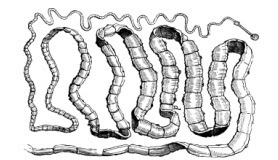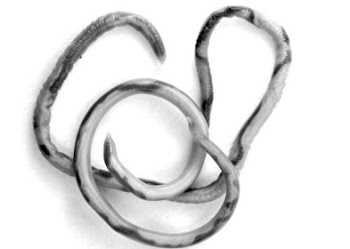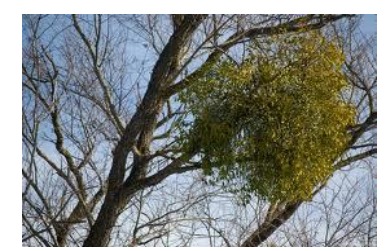INTRODUCTION
Pests
Pests are living organisms that cause damage to livestock, crops, humans or land fertility. Pests cause damage to crops and livestock by feeding on them and thereby cause diseases to them. This is because most pests serve as transmitters of disease-causing pathogens from a sick person or animal to a healthy person or animal. Such pests are known as vectors.
Examples of pests are mosquitoes, house flies, tsetse flies, etc.
Parasites
Parasites are organisms which live in or on another organism, called a host, usually causing it some harm. A parasite is generally smaller than the host and of a different species. Parasites are dependent on the host for some or all of their nourishment.
For example, tapeworm, a flattened worm that lives in the gastrointestinal tract of mammals, lacks an intestine of its own and must absorb pre-digested food from the intestine of its host. This food is the tapeworm‘s only energy source for growth and reproduction.
Types of parasites
There are two types of parasite. They are endoparasites and ectoparasites.
Endoparasites: These are parasites which live in the bodies of their hosts. Examples of endoparasites are tape worm, liver fluke, guinea worm, round worm etc.
Ectoparasites: These are parasites which live on the bodies of their host. Examples of ectoparasites are flea, louse, tick, mite etc.
TYPES OF PEST AND PARASITES OF HUMAN, FARM ANIMALS AND CROPS
Humans are subjected to numerous protozoan, worm, and insect-related parasites. Two of the most damaging human parasites are the protozoan plasmodium that causes malaria and the flatworm schistosoma that causes schistosomiasis.
There are an estimated 400 million to 600 million cases of malaria each year and 200 million cases of schistosomiasis worldwide. Anopheles mosquito (Malaria) Malaria is an infectious disease caused by a one-celled parasite known as Plasmodium.
The parasite is transmitted to humans by the bite of the female Anopheles mosquito. The Plasmodium parasite spends its life cycle partly in humans and partly in mosquitoes.
(Female anopheles mosquito)
Transmission of malaria
Mosquito infected with the malaria parasite bites human, passing cells called sporozoites into the human’s bloodstream.
Sporozoites travel to the liver. Each sporozoite undergoes asexual reproduction, in which its nucleus splits to form two new cells, called merozoites.
Merozoites enter the bloodstream and infect red blood cells. In red blood cells, merozoites grow and divide to produce more merozoites, eventually causing the red blood cells to rupture. Some of the newly released merozoites go on to infect other red blood cells.
Some merozoites develop into sex cells known as male and female gametocytes.
Another mosquito bites the infected human and ingests the gametocytes. In the mosquito’s stomach, the gametocytes mature. Male and female gametocytes undergo sexual reproduction, uniting to form a zygote. The zygote multiplies to form sporozoites, which travel to the mosquito’s salivary glands.
If this mosquito bites another human, the cycle begins again.
(Life cycle of the malaria parasite)
Symptoms and treatment of malaria
The characteristic symptoms of malaria include.
Cold, headache and weakness
Shivering
High fever
Excessive sweat as a result of drop in temperature
Prolonged infection results in anaemia and enlarged spleen.
Drugs such as chloroquine, camoquine, atesunate and amodiaquine can be used to prevent infection in the blood. An infected person should seek a health professional‘s advice immediately.
Control and prevention of malaria
1. The use of insecticides and mosquito repellents to kill and drive mosquitoes from an area.
2. Destroying the mosquito larvae and pupae by spraying oil on their breeding areas such as pools, marshes etc. (The oil causes the larvae and pupae to sink as it lowers the surface tension of the water)
3. Draining mosquito breeding ground.
4. Introducing fish such as top minnow into the water to feed on the larvae and pupae.
5. Preventing mosquito bites by sleeping under treated nets, applying repellent cream on the body, covering windows with fine-mesh to keep out mosquitoes.
6. Taking prescribed anti-malarial drugs regularly.
Schistosomiasis or Bilharziasis
Schistosomiasis is a widespread disease caused by the infestation of the human body by flukes commonly called blood flukes, of the genus Schistosoma. These flukes cause serious diseases.
(Intestinal Schistosoma mansoni, seen under light micrograph)
(A leg infected with Schistosomiasis)
Life cycle of Schistosoma
Eggs discharged from the host hatch into larval forms in fresh water; from the water, the larvae, miracidia, invade the snail that acts as an intermediate host.
The larval form of the parasite undergoes partial maturation in the snail, and then escapes back into the water, as mature larvae called cercariae.
Humans are infected with Schistosoma when they enter water containing infected snails. The larval stages of this flatworm develop in the tissues of infected snails and eventually release fork-tailed cercariae into the water.
The cercariae penetrate human skin, lose their forked tails, enter the blood, and migrate to major veins in the liver, intestine, or urinary bladder.
Within about six weeks of infection, the juvenile worms develop into sexually mature adults measuring 1 to 2cm in length.
The males and females mate and produce microscopic eggs, some of which migrate to the liver and cause a condition known as cirrhosis.
Other eggs move into the intestines and are passed out in the faeces. When untreated human sewage enters waters containing the snail hosts, the eggs hatch and start a new cycle.
Control and prevention
1. Avoid swimming in or drinking from infected water.
2. Wear protective clothing such as water-proof boots and gloves when entering infected water.
3. Apply special ointments to block penetration of the larvae into the skin.
4. Use drugs such a molluscicides to kill infected water snails.
5. The drug praziquantel has proved effective in killing Schistosoma in humans.
(Life cycle of blood fluke, parasite of schistosomiasis)
Tapeworm
Tapeworms are flattened worms ranging in length from about 13mm to about 9m. The adult tapeworm is characterized by the presence of a head, or scolex, equipped with a crown of hooklets for attachment to the intestinal lining of its host. At the rear end of the scolex is a narrow neck, from which body segments, or proglottids, are budded off asexually.
(Tape worm)
Life cycle of tapeworm
Tapeworms may have a few or thousands of proglottids. The proglottids contain organs of sexual reproduction, each with both testes and ovaries; the segments farthest from the head mature most rapidly and, when ripe, separate from the main body of the worm and pass out with the faeces of the host animal.
These newly detached proglottids contain numerous eggs, and each egg contains an embryonic tapeworm.
When the living segment is ingested by another primary host, the proglottids regenerate a new scolex, which attaches itself to the intestinal wall, and the tapeworm resumes its growth by budding.
When eggs are ingested, they hatch in the intestinal tract and release larval forms, which burrow into the tissues of the host and form cysts
The larvae often exhibit specific selection of tissues in encysting; for example, one species attacks the liver in humans and dogs, whereas another attacks the brain in sheep, causing the disease known as gid or staggers.
When larvae are ingested by a primary host, usually in the form of encysted meat of the intermediate host, they are stimulated by the gastric juice to develop into adult tapeworms.
The adults attach themselves to the intestinal wall and absorb partially digested food through their body surface; tapeworms have no mouths or digestive canals.
(Life cycle of tapeworm)
Control of tapeworms
1. Cooking meat properly before eating
2. Maintaining good sanitary conditions
3. Regular de-worming or taking anti-parasitic and anti-inflammatory drugs to destroy parasites
Roundworm
Roundworms, also called nematodes are responsible for various diseases in humans as well as farm animals. An ascarid nematode, a species of roundworm is responsible for the disease ascariasis in humans, and it is the largest and most common parasitic worm in humans
(Roundworm)
Life cycle of roundworm
Roundworm normally gets into humans when an ingested fertilised egg becomes a larval worm that penetrates the wall of the duodenum and enters the blood stream.
From there it gets to the liver and heart and enters pulmonary circulation to break free in the alveoli, where it grows In 3 weeks, the larvae pass from the respiratory system to be coughed up, swallowed, and thus returned to the small intestine, where it matures to adult male and female worms.
Fertilization can now occur and the female produces as many as 200,000 eggs per day for a year. These fertilized eggs become infectious after 2 weeks in soil; they can persist in soil for 10 years or more.
(Life cycle of roundworm)
Trypanosomiasis
Trypanosomiasis, also sleeping sickness, is an endemic and sometimes epidemic chronic disease caused by a protozoan blood parasite, genus Trypanosoma. Trypanosomiasis is very prevalent in Sub-Saharan Africa. It affects both humans and farm animals.
Causes of trypanosomiasis
The parasite trypanosoma is carried by a blood-sucking insect known as tsetse fly. They also transmit a similar disease called nagana in domestic animals. Tsetse flies have mandibles modified into bladelike structures used to pierce skin. They readily feed on the blood of humans, domestic animals, and wild game.
(Tsetse fly)
Life cycle of tsetse fly
Female tsetse fly mates just once. After 7 - 9 days she produces a single egg which develops into a larva within her uterus.
About nine days later, the mother produces a larva which burrows into the ground where it pupates.
The mother continues to produce a single larva at roughly nine day intervals for her entire life.
The adult fly emerges from the pupa in the ground after about 30 days.
Over a period of 12-14 days it matures, mates and, if it is a female, deposits its first larva.
Thus 50 days elapse between the emergence of one female fly and the subsequent emergence of the first of its progeny.
(Life cycle of tsetse fly)
Control of trypanosomiasis
1. Destruction of the wild game upon which the flies feed.
2. Clearing of woodlands, and periodic burning to prevent the growth of brush.
3. Trapping of tsetse flies, control by natural parasites.
4. Spraying of insecticides in affected areas.
5. Exposing male tsetse flies to gamma radiation to make them sterile or sexually unproductive.
6. Introducing a large population of sterilized male tsetse flies into a wild population.
Mites
Mites are a group of parasitic organisms which normally bite or cause irritation to humans, animals and plants. They normally cause asthma as well as allergies in humans. Mites often have three pairs of legs in the larval stage and four pairs of legs in the nymph and adult stages. The mouthparts are adapted for piercing.
Life cycle of mites
The dust mite is a common mite found in human populations.
They normally prefer humid areas.
The average life cycle for a male house dust mite is 10 to 19 days.
A mated female house dust mite can last up to 70 days, laying 60 to 100 eggs in the last 5 weeks of her life.
In a 10-week life span, a house dust mite will produce approximately 2,000 faecal particles and an even larger number of partially digested enzyme-covered dust particles.
(A mite)
Control of mites
1. Using a recommended insecticide to control mites.
2. Destroying their hiding places. Mostly under carpets, in pillows and mattresses, etc.
3. Regularly cleaning or sweeping rooms.
4. Regularly washing beddings such as bed sheets and pillow covers.
5. Using air-conditioners to reduce the temperature and humidity of a room.
6. Dusting farm animals with recommended insecticides.
Tick
Ticks are bloodsucking parasites found mostly in woods, tall grass, and shrubby vegetation where they climb onto plants and wait to jump on a passing host. They are particularly sensitive to carbon dioxide and movement—signals that a host is nearby. Their grasping forelegs allow them to climb on a host. They quickly find a protected spot on the host's body, sink their mouthparts into the flesh, and begin to feed. When full, they drop off the host. Several diseases are transmitted to humans and domestic animals through tick bites or tick excrement. Some of these are spotted fever, relapsing fever, Lyme disease, tularemia, some forms of encephalitis, and Texas cattle fever.
(Sheep tick)
Control of tick
1. Keeping the surroundings clean.
2. Practicing rotational grazing
3. Spraying of animals with recommended chemical or dipping to destroy tick
4. Regularly changing animal bedding
5. Culling infected animals
6. Picking ticks from the bodies of host animals
Flea
Fleas are bloodsucking, wingless insects. Fleas lay their eggs under carpets, in the folds of tapestry, in refuse piles, and in other places that provide safety and adequate nutrition.
(Flea)
Life cycle of fleas
In 6 to 12 days the eggs hatch, becoming larvae with biting mouth parts. After a few days of voracious feeding upon organic refuse, the larvae spin cocoons and enter a pupal stage. The adult flea emerges from the cocoon in a few weeks.
Adult fleas, which are slightly more than 0.3 cm long, have broad, rather flat bodies, short antennae, and piercing and sucking mouth parts; their eyes are either minute or absent. Their long, powerful legs enable them to leap relatively high into the air. Several flea species infest household pets and domestic animals. The dog flea and the cat flea are two of the most common species, both of which are parasites also on human beings, poultry, and livestock.
Fleas are intermediate hosts of a common cat and dog parasite, the cucumber tapeworm. Tapeworm eggs are deposited in feacal matter, and some of these eggs may cling to the hair of the primary host. Fleas swallow the eggs, which then undergo some development in the flea. If an animal or person accidentally swallows an infected flea, an adult tapeworm develops in the new host. Dog eczema is usually associated with the presence of fleas.
(Life cycle of flea)
Control of fleas
1. Destroying the adults with insecticides
2. Making breeding places unsuitable for larval life.
3. Adult fleas are destroyed by bathing the host with strong soap and by applying insecticides or petroleum.
Louse (plural Lice) Lice are wingless parasitic insects which normally thrive in conditions of filth and overcrowding.
Effects of lice infestation
1. Lice usually bite their hosts and feed on loose skins.
2. Lice are carriers of typhus and relapsing fever.
3. Heavy infestations of lice may cause intense skin irritation, and scratching for relief may lead to secondary infections.
4. In domestic animals, rubbing and damage to hides and wool may also occur, and meat and egg production may be reduced.
5. In badly infested birds, the feathers may be severely damaged.
6. One of the dog lice is the intermediate host of the dog tapeworm, and a rat louse is a transmitter of murine typhus among rats.
Control of louse
1. Avoid overcrowding of humans and animals.
2. Avoid sharing combs and clothing with an infected person.
3. Infected animals should be culled.
4. Farm animals should be dusted with insecticides.
5. Maintain good sanitary conditions.
COMMON PEST AND PARASITES OF PLANTS
Some plants are parasitic on other plants while some other living organism only rely on plants for their survival. They include mistletoe, dodder, weevils, leaf hopper, etc
Mistletoe
Mistletoe is a widespread flowering plant parasite that grows on oak, apple, juniper, pine and other trees. Most mistletoe species are actually hemiparasites, or partial parasites. Their leaves, found on the surface of branches and trunks, produce sugar through photosynthesis, but their roots penetrate into the host tree‘s tissue and absorb its nutrients. Some species of mistletoe lack leaves altogether and rely solely on their host tree to provide all their nourishment.
(Mistletoe)
Dodder
Dodder, also called love vine, strangle-weed, goldthread, and hell-bind is one of the few higher plants that are parasitic on other plants. It has yellowish or reddish threadlike twining stems and no leaves or chlorophyll.
During germination, the plant attaches itself to surrounding vegetation by means of sucking organs called haustoria, through which it takes nourishment from the host. Dodder is especially harmful to clover, alfalfa, and flax and is also found on ornamental plants. Commercial clover and alfalfa seed is always specially treated to avoid contamination by dodder seed.
(Dodder)
Weevils
Weevils are among the most destructive of pests that attack crops. They feed entirely on plant life, causing much damage to crops. Adult weevils lay their eggs in stalks or seeds of crops such as cotton, wheat, rice, and alfalfa. As larvae, weevils then feed on these plant tissues, extensively damaging the plant in the process. There are about 30,000 to 40,000 species of weevils some families or subfamilies of weevils include fungus weevils, primitive weevils, snout weevils, leaf-rolling weevils, grain weevils, flea weevils, acorn and nut weevils.
(Some species of weevils)
Control of weevils
Weevils can be controlled by
1. Burning infested fruits, nuts, or stems;
2. Ploughing the ground in which the insects pupate;
3. Spraying crops with insecticides.
Leafhoppers
Leafhoppers have piercing sucking mouthparts for feeding on the juices of vegetation. In doing so, they may also transmit viral and fungal diseases from plant to plant and can cause extensive damage to shrubs, field crops, and fruit trees. Sweet liquid called honeydew composed of unused sap and other excretions that they exude from their anus is eaten by ants and other insects. Leafhoppers lay eggs in leaves and stems.
(Leafhopper)
TEST QUESTIONS: ANSWER THE FOLLOWING QUESTIONS
1. Briefly explain the following terms:
(a) pest;
(b) parasite.
2. Describe how female anopheles mosquitoes transmit malaria. . (a) Mention four symptoms of malaria.
(b) State four methods of controlling malaria.
3. Describe the life cycle of schistosoma.






















No comments:
Post a Comment